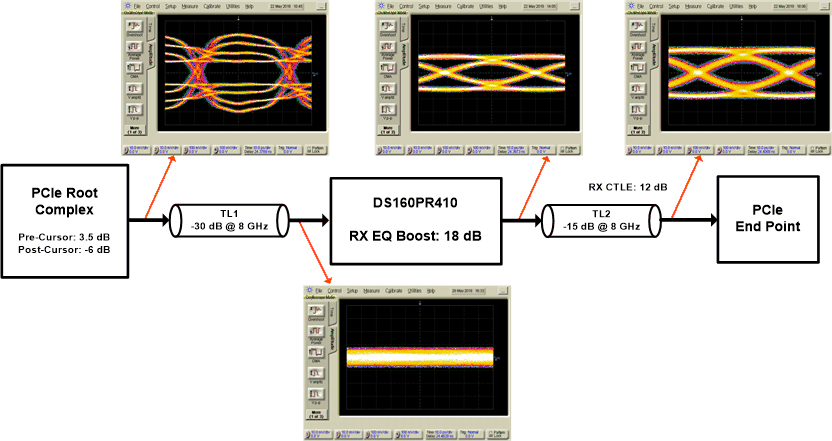JAJSHS2 August 2019 DS160PR410
ADVANCE INFORMATION for pre-production products; subject to change without notice.
- 1 特長
- 2 アプリケーション
- 3 概要
- 4 改訂履歴
- 5 Pin Configuration and Functions
- 6 Specifications
- 7 Detailed Description
- 8 Application and Implementation
- 9 Power Supply Recommendations
- 10Layout
- 11デバイスおよびドキュメントのサポート
- 12メカニカル、パッケージ、および注文情報
8.2.1.3 Application Curves
The DS160PR410 is a linear redriver that can be used to extend channel reach of a PCIe link. Normally, PCIe-compliant TX and RX are equipt with signal-conditioning functions and can handle channel losses of up to 28 dB at 8 GHz. With the DS160PR410, the total channel loss between a PCIe root complex and an end point can be up to 45 dB at 8 GHz.
Figure 5 shows an electric link that models a single channel of a PCIe link and eye diagrams measured at different locations along the link. The source that models a PCIe TX sends a 16-Gbps PRBS-15 signal with P7 presets. After a transmission channel with –30 dB at 8-GHz insertion loss, the eye diagram is fully closed. The DS160PR410 with its CTLE set to the maximum (18-dB boost) together with the source TX equalization compensates for the losses of the pre-channel (TL1) and opens the eye at the output of the DS160PR410.
The post-channel (TL2) losses mandate the use of PCIe RX equalization functions such as CTLE and DFE that are normally available in PCIe-compliant receivers.
 Figure 5. PCIe Gen-4 Link Reach Extension Using DS160PR410
Figure 5. PCIe Gen-4 Link Reach Extension Using DS160PR410